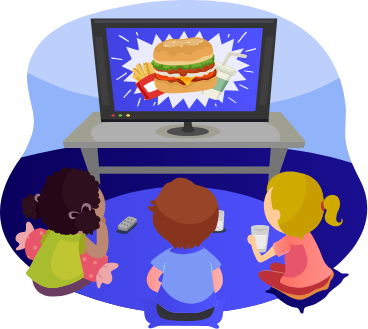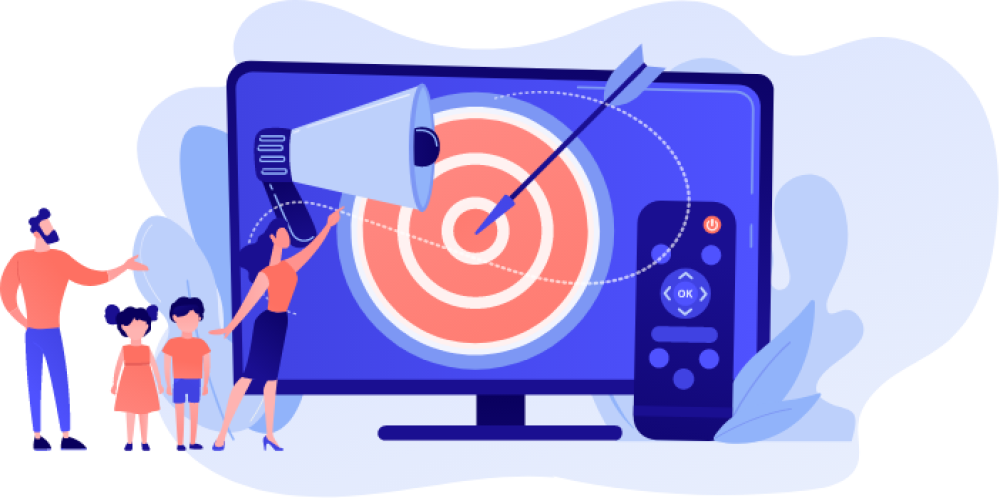Parents quickly learn that children's advertisements lurk everywhere, for example, on TV and YouTube, in unboxing videos, and even inside their kids' favorite games and educational apps. In 2021, these ads are increasingly digital (and sneakier).
Advertising to children is a sensitive issue. Kids are more likely than adults to take ads at face value and not think about hidden motives. This guide covers both children's advertising and general advertising. We aim to help parents and caregivers teach children to think critically about ads. We also offer tips to limit children's exposure to regular and targeted ads.
Table of Contents
- View from the Experts
- Talk with Children about Misleading Ads
- Some Forms of Children's Advertising
- Claims or Implications Made in Children's Advertising
- A Look at General Advertising
- Limit Children's Exposure to Misleading Ads
- Read the Fine Print on Privacy and Data Collection
- A Brief Review of COPPA
- References and Footnotes
- Additional Resources
View from the Experts
"What's unique about [influencer content] is that it feels more personal. Kids form an attachment. [Because many young influencers film their videos in their bedrooms] it feels right out of their home. So it probably has more power than if it's just an actor trying to sell somebody a product."
"As a child influencer, [Ryan] is being courted by companies to play with the latest toy so that other children can see it. But now, the child influencer himself has become a brand that is then being put into Walmart, and Target, and Amazon as its own force and influence. It's pretty shocking."
"Advertising, in and of itself, is harmful to children. Marketing targets emotions, not intellect. It trains children to choose products not for the actual value of the product, but because of celebrity or what's on the package. It undermines critical thinking and promotes impulse buying."
"I'm concerned about digital disparities. Children from lower-income families are more likely to play free apps, which are packed with more distracting and persuasive ads."
Talk with Children about Misleading Ads
Many parents fall into one of the three camps below. You might, too, or perhaps you belong in more of an in-between area. Whatever the case, it's never too late to start educating your children about ads.
Camp A:
Your children are very young, maybe even infants. They haven't had much, if any, exposure to ads. You're researching ways to eventually help them with ads and digital literacy.
Camp B:
Your children get screen time. Could be a little, could be a lot. Either way, ads do not seem to influence them much. However, ads disturb you on some level. It could be their loudness, their prevalence, or just the sheer commercialism. Even your children's educational apps teem with spam and greed. You'd like to get ahead of the game and start talking with your children about advertising.
Camp C:
Ads have worked their curses on your kids, who clamor for the newest toys and tech devices. Older children may even exhibit new or stepped-up behaviors such as wanting diet pills or talking badly about themselves. You're here for damage control and to prevent such issues in the future.

Younger Children May Not Even Know Ads Are Ads
Adults can usually tell the difference between ads and regular programming. Children, especially kids younger than seven, may not be able to.1 Many advertisers take advantage of this fact to make their ads wildly entertaining. Some children even prefer to watch ads over regular content.
Children eight and older are generally able to distinguish between ads and normal programming. However, they are unlikely to intuitively understand how ads work—for example, that ads are often exaggerated or misleading.
Start Today If You Have Not Already
Start discussing ads with your children as early as you can. To get the ball rolling, review this handout from Media Smarts. It uses a Nesquik Bunny commercial as an example of something young children might not recognize as an ad. Also, check out this adversmart interactive on food marketing.
The list below gives plenty of other ideas for conversations, but there's no need to follow it step by step. Hop around depending on your kids' age and relationship to ads.
1. Discuss the differences between ads and regular content. Show the kids a few examples of print ads versus regular photos. Also, show them a video ad and then a clip from a regular TV show. Point out the ads and how you know (branded character, text on a photo, mention of a product, etc.).
Explain that companies use ads to sell products. Sometimes, ads feature cartoon characters, favorite celebrities, and funny behaviors. Ads are common for sugary breakfast cereals, breakfast bars, juice, clothes, toys, movies, and TV shows, among others. There can even be ads for destinations—think Disneyland or zoos. Some are "advergames," half-ad, half-games sponsored by brands.
- Ads don't tell people straight out, "Buy this product," but their goal is to make you want the product even if they have to mislead to do it.
- Ads present products or brands in a cool, often false, way. For example, many celebrities or influencers are paid for their work. They don't use these products in their real life. Similarly, game pieces don't really come to life like they might in an ad for a board game.
- Just because an ad is cool doesn't mean the product is. Making a great ad is easy, but making a great product is hard. Heck, you and the kids could create an excellent ad for something you don't like. Try it out!
Your kids may not immediately grasp the distinction between what's an ad and what's not. Give them time. Point out plenty of examples over weeks or months.
2. Request that your kids make two lists, one of things they value (real life) and the other with what they'd like to buy (wish list). You can do your own list too, for comparison and contrast purposes. Ask whether the items on your kids' wish list will make them happier, and if the answer is yes, why.
Discuss why they value the real-life things they chose. (Your list comes in handy here, too.) There aren't any right or wrong answers, but it's valid to mention whether your child played with a shiny new toy for just a day or two before breaking it or going back to another preferred toy. Discuss meaningful experiences versus quick thrills and whether your children even wanted X item before seeing the ad for it. This is a good place to discuss your kids' favorite ads. What makes these ads memorable? What do they think the advertisers' motivations are? Why do the kids like the ads so much?
Take note of what may be missing in your children's lives. If they think wish-list items will make them less lonely or more accepted at school, you have an excellent opportunity to discuss alternative approaches to these problems. The list could also be a good jumping-off point for discussions on money. Talk about the fact that ads feed into a consumer culture that prioritizes spending money.
3. Talk about being a smart, savvy shopper. Show the kids how to comparison shop. For instance, if your children want dolls, help them compare several brands. Get them to evaluate these dolls critically. Use metrics that matter to them (maybe durability and range of accessories). Depending on the kids' age, you can even go into environmental considerations, reviews, and warranties.
4. Explain that advertisers make people want things they didn't want before. Advertisers make it sound like their products solve problems and make people happier, claims that are usually not true. Use examples from personal experience or your kids' experiences to illustrate.


5. Investigate the claims made in food and beverage ads. Give the kids age-appropriate information on nutrition and how to tell if something's healthy. You can go into sugar, serving sizes, ingredient lists, calorie counts, and more, depending on the kids' ability to understand.
Suppose an ad says a particular cereal is part of a healthy breakfast. You and the kids can compare the cereal's nutritional profile to something that is healthy for sure. What are the differences, especially with sugar and perhaps the number of ingredients involved? Is the "healthy breakfast" claim valid?
Take a similar approach to fast-food ads. The food itself isn't healthy, although it can be OK in moderation. Compare nutrition information and explain how restaurants use ads, toy tie-ins, TV shows, and movies to hook kids.
FoodCorps has a lesson plan for discussing the secret strategies of food advertising. Even if you don't do the lesson plan, read it. The primer touches on sneaky language, celebrity endorsements, perfect-looking families, and competitor insults.
Also, tell your kids that special artists make foods and drinks look delicious in ads. The syrup on these yummy pancakes? Probably engine oil. That colorful ice cream? Probably mashed potatoes or a non-ice-cream paste. The milk in that cereal is most likely glue. The list goes on…and on…and on. The misdirection is everywhere.
6. Point out ads around your children. Do this casually or turn it into a scavenger hunt (or both!). Even a simple riffle through your kids' closets could turn up plenty of branded clothes (Nike, Paw Patrol, SpongeBob, Disney princesses, etc.). Go through your smartphone or the kids' tablet to show them all the ads in their favorite apps. Point out the ads at baseball stadiums, theaters, and even their own schools. If your child watches influencers or unboxing videos, explain that they are often ads, too. Companies send these people their products and, many times, tell them what to say.
7. Explain about stereotyping and illusions. Ads might show mostly girls (or boys) playing with one type of toy or color. More products for advertisers to sell! Stereotyping also occurs along racial and body image lines. Children, families, and pets in ads may always look perfect: shiny clothes, well-brushed hair, huge houses, always smiling. Discuss how realistic that is.
8. Work on a project. Media Smarts offers "Advertising All Around Us" projects that are fun and pretty simple. They make for a good bonding experience but can be independent projects. At a minimum, skim over the lesson plans before talking about ads with your kids. For instance, they touch on techniques such as scale (making a toy look bigger than it really is), repetition (saying the same stuff again and again), omission (leaving out important details), and bandwagon (everyone wants this toy!).
We'll end this section with advice from the American Academy of Pediatrics:2

Some Forms of Children's Advertising
Parents and caregivers might not realize how omnipresent advertising is. For instance, toy company Spin Master got the ball rolling on the kids' show Paw Patrol. Likewise, many shows have advertisers involved from the very start. Fast food companies and other food and beverage companies also use "advergames" to promote their brands. That can lead to unhealthy eating.3 So, let's take a quick look at some different forms of children's marketing and advertising.
YouTube/YouTube Kids programming: YouTube features official kids' shows with regular children's advertising. Some of it might be targeted despite settlement agreements.
However, folks can make lots of money right from their living rooms, thanks to pretend play, educational content, unboxing, and toy-review videos. Children love to watch all these types of programming.
Sometimes, the messages are educational or socially relevant—anti-bullying, for example. Whatever the storylines, the aim is to put on content that kids watch. For instance, you can view many iterations of Anna and Elsa dolls from the Frozen movies go to regular school, do Play-Doh projects, and even play with Paw Patrol characters. "Anna" and "Elsa" do all the things viewer kids love to do with their own toys. The settings are rarely glamorous. These toys play in regular rooms and ordinary back yards. Often, the video production quality isn't noticeably above average. The more eyeballs these videos get, the more ad money for their creators.
Then there are influencers such as Ryan Kaji. The young star of Ryan's World and other YouTube channels earned $29.5 million in 2020, thanks to ads in unboxing and toy-review videos, and other endeavors. However, the Federal Trade Commission may look into allegations that Kaji's sponsors aren't always disclosed, or properly disclosed.4
YouTube Kids doesn't allow paid product promotion, but plenty falls through the cracks. Making the issue more confusing, regular YouTube allows paid product promotion.

YouTube used to run targeted ads (and may still, it's unclear). The practice reportedly ended after a settlement with the Federal Trade Commission. Apparently, YouTube had been collecting the data of kids under age 13, which violated the Children's Online Privacy Protection Act (COPPA). These data collection efforts allow (or allowed) YouTube ads to target kids by age, gender, and other factors. YouTube, through its parent company Google, also had to pay a multimillion-dollar fine.5
Merchandised shows: Many shows got their start due to toy companies or are shows with heavy merchandising ties. Think Paw Patrol, Ninjago, Dora the Explorer, and Peppa Pig, among others. With Ninjago, the entire show is animated toys—Legos, to be exact. This type of TV show development became legal after the 1980s deregulation of children's TV.
Advergames: Advergames are gamified ads that reward consumers for buying or using products.6 One way to think of them is as half-ad, half-game. Advergames are common on websites and in children's apps, even paid and educational apps. After playing, children may be more likely to eat unhealthy foods and drink sugary beverages. Traditional or regular TV ads: These are the regular ads you see during commercial breaks on broadcast and cable TV. They include ads on channels such as Nickelodeon and Cartoon Network. Many streaming services and YouTube also show regular ads, although ad-free experiences are available.
Claims or Implications Made in Children's Advertising
Let's look at the messages, direct and indirect, that many kids receive from ads.
My happiness or popularity depends on getting specific items. Everyone who has the new hot item looks so cool and happy!
Materialism rules. A constant influx of ads and unboxing videos can make children feel inferior. They might feel their life is lacking if they don't have a lot of toys.
Stuff is easy to get. These kids have all these toys! Why can't I? Children don't always understand that influencers get many products free. Unboxing videos easily create the impression that everything a child could want is there for the getting.
I'm superior (or inferior) to my peers. If you have X product, you're better. If you don't have it, you deserve to be mocked or to have your self-confidence dashed.
I must have the toy NOW! I can't wait! Many ads foster an atmosphere of urgency.
Only girls (or boys) play with this toy. I'm weird for wanting it. Gender stereotypes are common in ads.
Certain behaviors are fine or safe. Ads often feature unsafe behaviors and stunts. Some kids don't understand that these ads are exaggerations.7
If I get the product, I can live like the child in the ad! Ads portray many children living in huge, impeccably clean houses with perfect families, treehouses, and pools. There's little conflict. In other words, ads are a breeding ground for a mishmash of feelings such as envy, desire, inferiority, jealousy, awe, and confusion.
This celebrity I trust says the product is awesome, so it genuinely must be. Children trust celebrities. Sometimes, that trust is misplaced. For instance, children may not realize these celebrities get paid to do ads and might not actually use the products.
This food or drink is delicious. It will make me feel so much better. In reality, food and drink ads are one cause of child obesity. The ads also contribute to an environment where children don't move or exercise as often. Unilever (Klondike, Ben & Jerry's) is one company trying to be more responsible and realistic about how children could interpret its ads. Among other measures, the company won't use influencers under 12 years old or influencers whose primary appeal is to children under 12.8
I should get rewarded for most stuff (and learning is hard). Many apps and advergames reward children for right answers and even for just opening the app. This type of constant affirmation drives external motivation instead of internal motivation. It can also result in burnout. Children who don't get constantly rewarded during other forms of learning might conclude that learning is hard.9
A Look at General Advertising
As the name implies, general advertising is for general audiences. It's not targeted to kids, although plenty of children see these ads, for instance, on the fences of baseball stadiums, in a match-three smartphone game, and in YouTube videos.
Many general ads don't appeal to kids. However, some forms can be especially harmful, leading to misconceptions about tobacco, electronic cigarettes, alcohol, body image, and more. The following bullet points are from an American Academy of Pediatrics report and deserve special attention:2
— "Studies have revealed increased exposure to alcohol content for middle and high school youth via social media, banner ads, and video ads, with disparate exposure for African American, Hispanic, and American Indian youth."
— "…a positive correlation between marketing exposure and receptivity and alcohol consumption in youth…"
— "The legalization of marijuana in many states has led to media and point-of-sale advertising seen by people younger than 21 years or increased exposure through social media mentions, sometimes accompanied by cartoon characters or other design elements attracting to children."
— "By presenting ideals of body appearance, ads can convey cultural biases, such as skin color (eg, skin-lightening products), hair traits (eg, hair-straightening products), or unhealthy body weight ideals (eg, diet products or muscle-building supplements). In addition, ads for indoor tanning salons often target teenagers. Because indoor tanning is considered a class 2 carcinogen, such advertising is restricted over traditional media. For this reason, tanning salons actively use social media as a strategy for attracting and retaining customers, encouraging high-frequency tanning, and lowering the perception of the risks of tanning."
Whew. That's a lot to unpack. Your child is potentially exposed to numerous social media posts and ads on alcohol, marijuana, diet supplements, and tanning every day.

As always, keep the lines of conversation open. If your kids are on social media, get on these platforms yourself. Dive into Instagram, TikTok, or the apps your kids use so you have a better idea of the lingo, content, and ads there.
Your teens probably know not to take social media content at face value. Still, they may be curious about certain products or services, especially if their friends are involved. There's only so much you can do with teenagers. For example, taking their phones away or prohibiting social media makes that forbidden fruit more enticing. It also makes you seem out of touch. It's a recipe for kids to sneak around behind your back.
If your children have favorite influencers or social media channels, find out who, what, and why. Ask questions and develop your own preferences. Try to avoid judging. Listen and learn. You and your children have a lot to teach each other.
One more thing: It's normal for teenagers to feel embarrassed, inferior, abnormal, or what have you. Ads that feature laughing, perfect-looking people don't do wonders for most people's self-esteem. Start as early as possible in your children's lives to expose them to the world, to shape them into well-rounded, thoughtful, active learners and critical thinkers. Give them multiple tools in their arsenal. They should have skills or traits they're proud of, even if issues such as acne, weight, or changing bodies make them want to be someone else. As their parent, be someone they feel comfortable confiding in, and make sure they have other people to talk to. Kids deserve to feel safe with their parents and with multiple adults.
Limit Children's Exposure to Misleading Ads
Talking with your children about ads is just one part of the picture. To limit your children's exposure to ads, take steps such as these (more effective and realistic with younger children):
- Set up devices so only you are allowed to download apps. This way, you can review apps, their ads, and their privacy/data collection settings before your kids use them. Prioritize apps that don't constantly interrupt learning with ads or requests for in-game purchases.
- Look for active, physical, or hands-on alternatives. For instance, if you're teaching your kids math, you could engage them with actual, physical wooden blocks instead of using an app.
- Limit screen time. Perhaps they're allowed to watch only an hour of YouTube per day, for instance.
- Restrict screen use to common areas of the house.
- Use tools such as ad blockers and VPNs.
- Maintain open lines of conversation about what your kids read, watch, and play. If you have a family media use plan, use it as a point of entry into conversations about media savviness and data collection.

Read the Fine Print on Privacy and Data Collection
In an ideal world, you would download apps before your kids use them. That does not always happen in reality, especially when apps are free or kids want them right now. Go on their devices every once in a while to review the apps, games, and shows they consume. Of course, do it with their knowledge and back off when it is age appropriate. Two goals during this review process are to ensure your children:
- Access content with clear privacy and data collection settings.
- Do not receive targeted ads.
To further limit data collection, use tools such as high privacy settings, ad blockers, tracker blockers, and VPNs. Be very selective about the information you share online and on social media.
Explain the importance of reading the fine print, especially if your children are older and you don't go through their devices. Common Sense Media has a good primer on privacy policies with a list of recommended apps.10
- No privacy policy at all? Don't download the app.
- Free? Approach with extreme caution or don't download. Free apps are more likely to sell or share user data, and to show targeted ads. Targeted ads are based on certain traits or behaviors such as browsing or search history. This type of customization can make targeted ads more dangerous and effective. It can also result in more misleading ads on shared devices.
- Many educational apps have lousy privacy policies. Developers can slap the term, "educational," on apps to make them seem more reputable.
- Go with the minimum amount of information required to use an app. For instance, don't enable location or camera settings if you don't need to. Don't give your name, address, and phone number if none of these are necessary.
Why are data collection and privacy so important, though? The answers are tricky. They can be hard for teens and even adults to wrap their heads around. Basically, they go like this:
- A lack of data collection permissions reinforces advertisers' "bad" behavior with younger kids who are more susceptible to targeted ads.
- The Children's Online Privacy and Protection Act (COPPA) decrees that only general audience apps are allowed to do targeted ads. In other words, children's apps should not be able to—but they do, by designating their apps for general audiences.2
- Advertisers take data to make informed guesses as to any health conditions you have, whether you want to lose weight, if you're pregnant, your political and religious leanings, and even your sexual orientation, among other issues. They collect and sell information on thousands of traits to third parties.
- Once the data is there, it is there to stay. Advertisers may say it's possible to restrict or erase your data, but this is a half-truth at best. Data collection algorithms are multifaceted. Data brokers operate with few rules and aren't transparent. That is not behavior anyone should reward or reinforce.
- The data can do real-world harm, especially when it comes to race, jobs, income, insurance, and loan applications.11 Stalkers or other unsavory people can pay people-search sites for access to a wealth of data on specific individuals. Hackers and identity thieves can also gain access to data such as your birthday and Social Security number. Even if no actual harm is done, it's annoying to constantly get spam emails and calls. (Answer a quote for car insurance with purposefully wrong information, and wait for the "John Doe" emails to roll in.
A Brief Review of COPPA
COPPA, or the Children's Online Privacy and Protection Act, is a 1998 law revised in 2013. Its purpose is to give parents control over information collected online on their young children (under 13 years old). It applies to mobile apps, smart toys, online services, and commercial websites, among others. General websites with knowledge they serve children under 13 are required to comply, too.12 A few highlights on what COPPA requires of these businesses and advertisers:
- Post clear privacy policies that describe their practices for information collected on children.
- Get parental consent to collect information.
- Give parents a choice between data being used internally and being disclosed to third parties, with transparently explained exceptions for integral services.
- Give parents access to their children's information and the ability to have it deleted.
Foreign-based websites and online services that U.S. children use must comply. The reverse is true as well. An American company focusing on children in another country must follow COPPA's regulations.
COPPA defines personal information as the child's name, address, online contact information, screen name, Social Security number, telephone number, geolocator, a photo, video, or audio file, or persistent identifier such as a customer name in a cookie, among others.
COPPA has its fair share of weaknesses. For instance, children can enter their age on a website as, say, 15, 18, or even 30. COPPA also doesn't apply to children 13 and older. Enforcement is spotty at best.

Protecting and Educating Children on Misleading Ads
The United States gives advertisers, even children's advertisers, a lot of leeway. By contrast, Quebec in Canada and countries such as Sweden don't allow commercial advertising targeted at children younger than 13.
So, U.S. parents and children often find themselves inundated with ads for sugary breakfast cereals, high-calorie drinks, trendy toys, and much more. These ads can be extremely entertaining, even to the point that young children prefer them to regular content. Children under seven years old may not even be able to tell the difference between an ad and regular programming.
It's never too late for parents to discuss advertising and digital literacy with their kids, although the earlier, the better. Get your children to think about advertisers' motivations and how companies are able to sell products that aren't healthy, that break easily, or that were not in demand previously. It'll be fun and eye-opening for your kids to create an advertisement for something they dislike to make it sound appealing.
Tools such screen time limits, ad blockers, and COPPA help you monitor advertisers' reach and data collection practices. Of course, they do only so much. By the time your children turn 13 and are not protected under COPPA, they'll ideally be able to see through ads and be capable of reviewing products in a logical way.
References and Footnotes
1. Talking to Kids about Advertising. (2016). Media Smarts. Retrieved Jan. 4, 2021, from https://mediasmarts.ca/tipsheet/talking-kids-about-advertising-tip-sheet
2. Radesky, Jenny, et al. (2020, July 1). Digital Advertising to Children. American Academy of Pediatrics. Retrieved Jan. 4, 2021, from https://pediatrics.aappublications.org/content/146/1/e20201681
3. Fetters, Ashley. (2020, Feb. 02). Toy Commercials Are Being Replaced by Something More Nefarious. The Atlantic. Retrieved Jan. 4, 2021, from https://www.theatlantic.com/family/archive/2020/02/how-toys-are-marketed-kids-without-cable-tv/605920/
4. Neate, Rupert. (2020, Dec. 18). Ryan Kaji, 9, Earns $29.5m As This Year's Highest-Paid YouTuber. The Guardian. Retrieved Jan. 4, 2021, from https://www.theguardian.com/technology/2020/dec/18/ryan-kaji-9-earns-30m-as-this-years-highest-paid-youtuber
5. Bastone, Nick. (2019, Aug. 20). YouTube Will Reportedly Stop Serving Targeted Ads on Videos for Kids in a Move That Could Cost It Tens of Millions of Dollars Per Year. Business Insider. Retrieved Jan. 4, 2021, from https://www.businessinsider.com/youtube-to-end-targeted-ads-kids-ftc-investigation-2019-8
6. Meyer, Marisa, et al. (2019, Jan.). Advertising in Young Children's Apps: A Content Analysis. Journal of Developmental & Behavioral Pediatrics. Retrieved Jan. 4, 2021, from https://journals.lww.com/jrnldbp/Abstract/2019/01000/Advertising_in_Young_Children_s_Apps__A_Content.4.aspx
7. Jones, Daisy. (2016, Dec. 29). Stunts and Potentially Unsafe Behaviour in Ads – Where to Draw the Line. Osborne Clarke. Retrieved Jan. 4, 2021, from https://marketinglaw.osborneclarke.com/advertising-regulation/stunts-potentially-unsafe-behaviour-ads-draw-line/
8. Graham, Megan. (2020, Feb. 12). Unilever Will Stop Advertising Ice Cream to Kids over Obesity Concerns. CNBC. Retrieved Jan. 4, 2021, from https://www.cnbc.com/2020/02/12/unilever-to-stop-targeting-food-ads-to-kids-over-childhood-obesity-concerns.html
9. A Guide to Choosing Tech for Your Preschooler. (2020). Campaign for a Commercial-Free Childhood. Retrieved Jan. 4, 2021, from https://commercialfreechildhood.org/pf/safe-secure-smart-apps/#1605564986780-4c58d881-058e
10. Educational Apps and Sites with Solid Privacy Policies. (n.d.). Common Sense Media. Retrieved Jan. 4, 2021, from https://www.commonsensemedia.org/lists/educational-apps-and-sites-with-solid-privacy-policies
11. Smith, Gary. (2018, Nov. 20). High-Tech Redlining: AI Is Quietly Upgrading Institutional Racism. Fast Company. Retrieved Jan. 4, 2021, from https://www.fastcompany.com/90269688/high-tech-redlining-ai-is-quietly-upgrading-institutional-racism
12. Complying with COPPA: Frequently Asked Questions. (2020, July). Federal Trade Commission. Retrieved Jan. 4, 2021, from https://www.ftc.gov/tips-advice/business-center/guidance/complying-coppa-frequently-asked-questions-0
Additional Resources

Media Smarts: What parents can do to deal with marketing and ads
Advertising Makes Us Unhappy: An investigation into ad spend and life satisfaction
COPPA: FTC resources on the Children's Online Privacy Protection Act
My Data and Privacy Online: This UK-focused website has plenty of useful information for children in other regions of the world
Food Marketing to Children and Adolescents: FTC reports, public statements, press releases, and more






